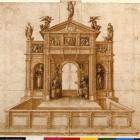Agostino Busti, known as il Bambaia, Design for an Altar
Agostino Busti, known as il Bambaia (1483-1548), Design for an Altar, circa 1515, metalpoint and sepia ink heightened in white lead on white paper, mounted, 297x331 mm (n. inv. 1218 C 138)
Before becoming part of Milan’s Civic Collections in 1929, along with a folio that represents the same architectural design with some variations, the drawing was part of the collection of the architect Carlo Amati, who had attributed it to Donato Bramante. Considered to be a proposal for an altar by Luigi Pungileoni and first attributed to Bambaia by Giorgio Nicodemi, the structure depicted is conceived as a triumphal arch: the main body, topped by a gable, accommodates two kneeling saints. At the centre is an archway, to the sides of which are the figures of the Annunciation. The two lateral niches house Saints Louis of Toulouse and Anthony of Padua. A frieze depicting five episodes from the life of the Virgin decorates the top of the structure, topped by the figures of the Redeemer, two angels and the evangelists John and Matthew. The design has been associated with the construction of an altar for the church of Santa Maria del Giardino in Milan. In 1515 Bambaia indeed participated in the competition held for the execution of this work, in collaboration with Geronimo Della Porta and Cristoforo Lombardi, but the altar was then built at a lower price by other artists between 1519 and 1523.
Recently a fascinating study attributed the drawing to the miniaturist and goldsmith Giovanni Giacomo Decio.








